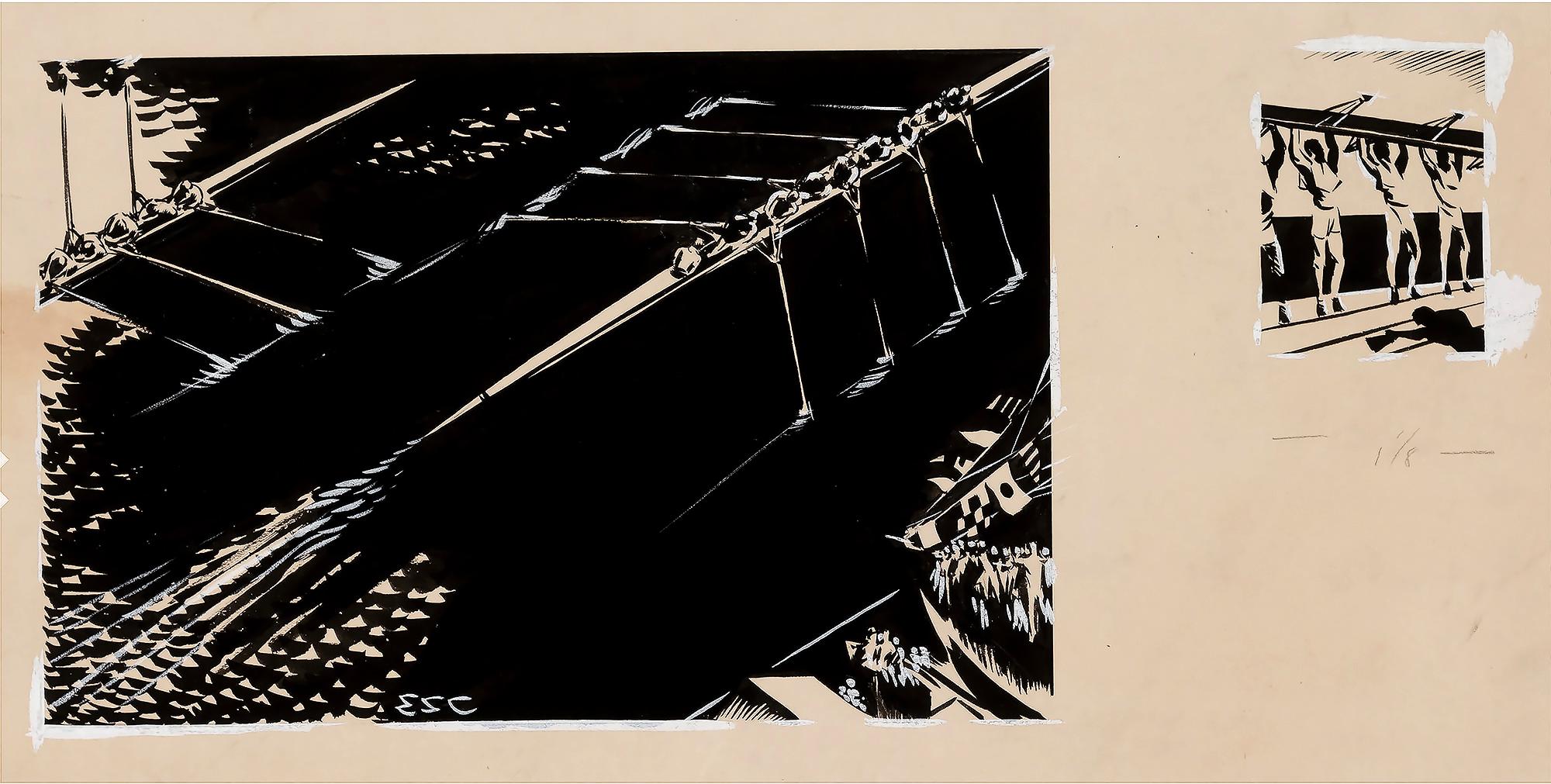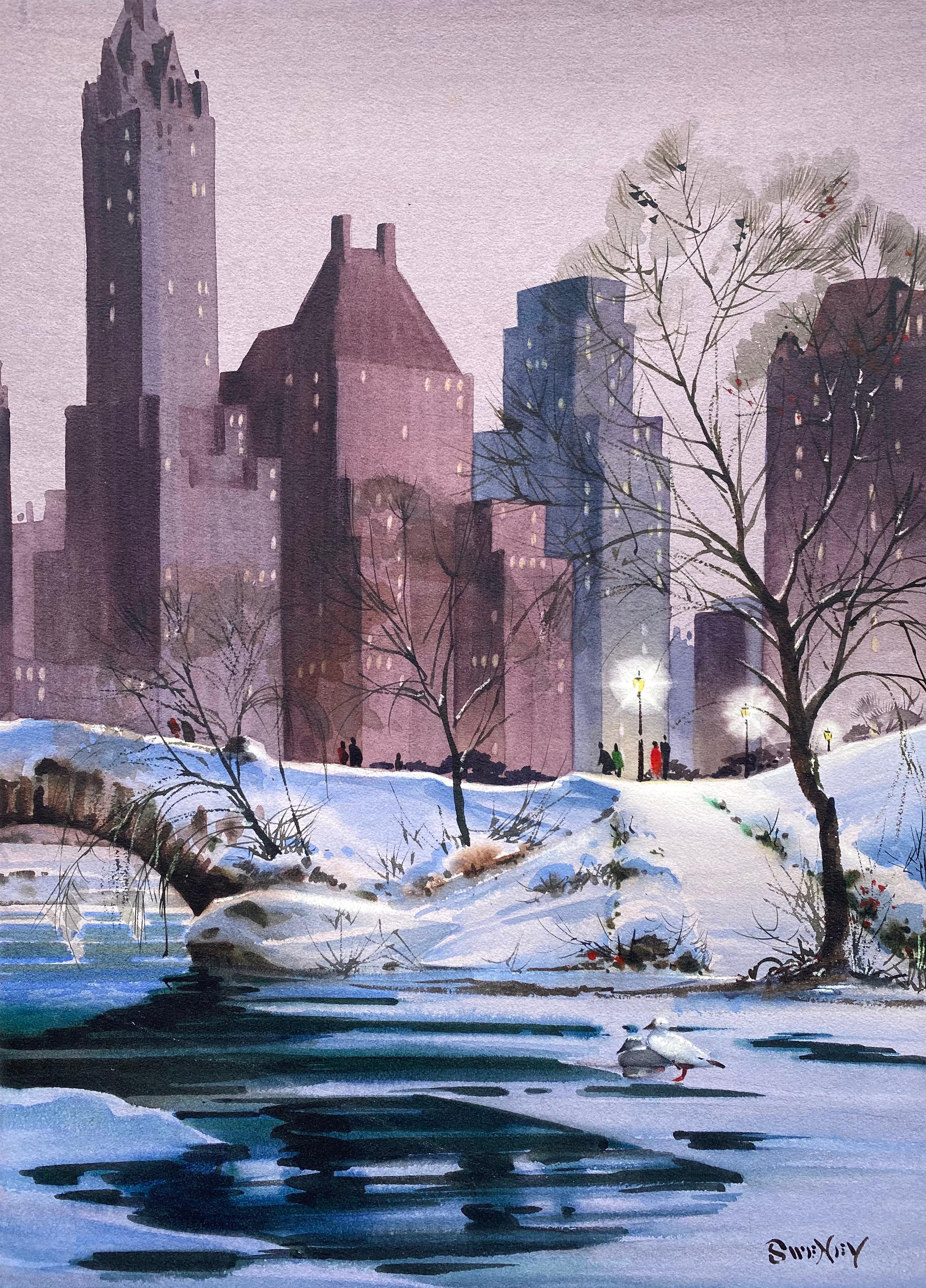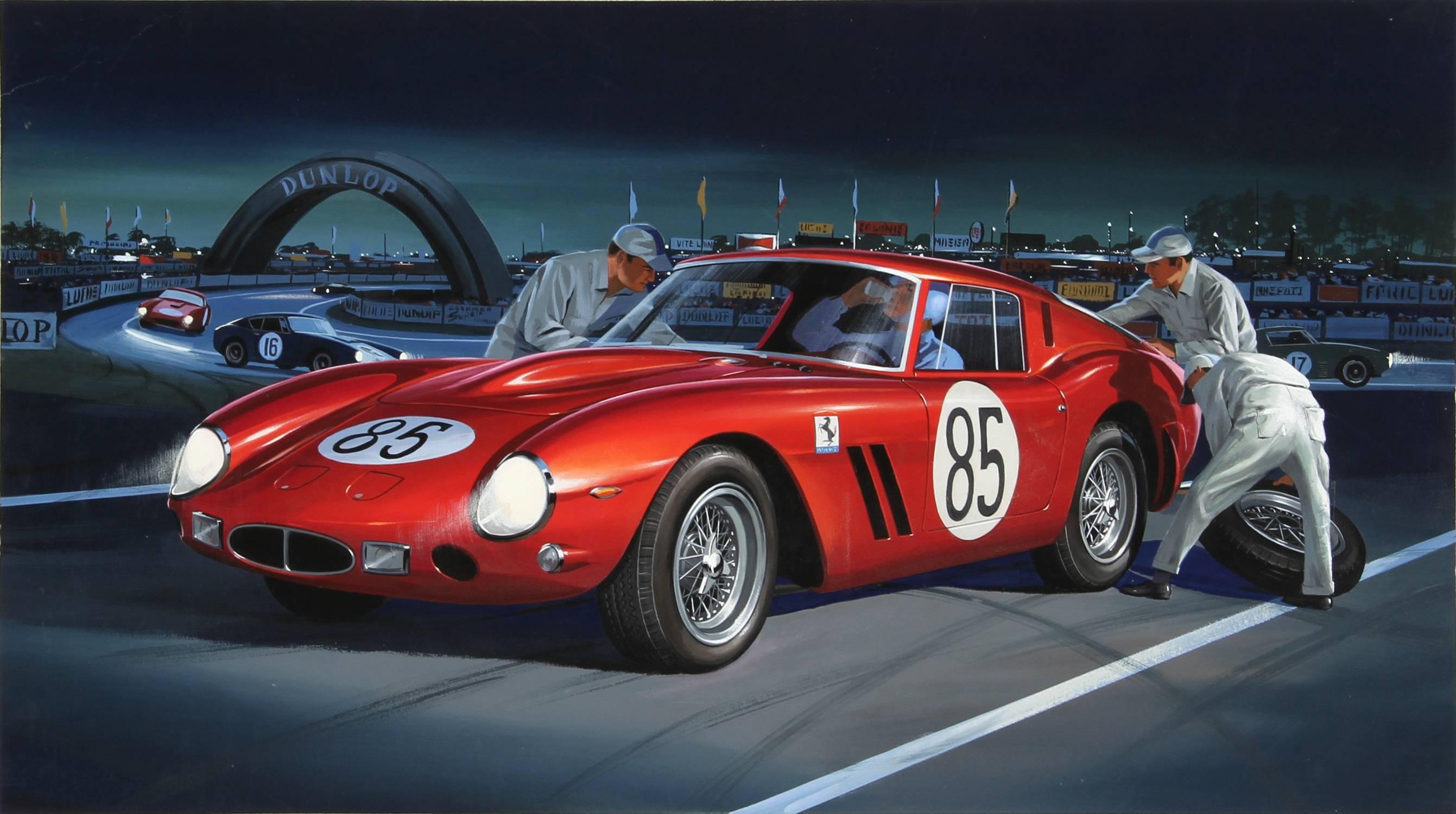Items Similar to Nero's Temple On The Nile
Want more images or videos?
Request additional images or videos from the seller
1 of 8
Willy PoganyNero's Temple On The Nile1947
1947
About the Item
Medium: Gouache on Illustration Board
Signature: Signed Middle Right
Sight Size 20.50" x 27.00;" Framed 30.25" x 35.00"
Framed and matted under glass in antique gold painted art deco frame
A large and important bustling published colorful gouache illustration painting by Willy Pogany for an interior story titled "Nero's Temple On The Nile", which appeared in the January 12, 1947 edition of Randolph Hearst's American Weekly Magazine. An over the top opulant Egyptian themed costumed imagining of life in ancient Rome, which appeared with the following story caption: "Feeling some remorse for his sinful past, or astutely making a political gesture to gratify his restive subjects, Nero apparently caused the temple to be rebuilt and then worshipped at its shrine." Artists that worked for this long running syndicated newspaper Sunday supplement included Henry Clive, Edmund Dulac, Victor Tchetchet, Mario Cooper and Willy Pogany.
William Andrew (Willy) Pogany was a native of Hungary and his first studies in Budapest and Paris were in engineering. Success in caricaturing led him to pursue and art career, first in London and then in America. His influences were the Oriental artists and illuminated books, and much of his career was devoted to book illustration.
Among his many successes were The Rubaiyat, The Kasidah, The Children’s Book of Northern Myths, The Witch’s Kitchen, The Frenzied Prince, Sonnets from the Portuguese, Fairy Flowers, Forty-Four Turkish Fairy Tales, Tales of the Persian Genii, A Treasury of Verse for Little Children, Stories to Tell the Littlest Ones, Hungarian Fairy Book, and Gulliver’s Travels. He also painted murals, did etchings, designed stage settings, and exhibited widely, the artist was also a favorite in Randolph Hearst’s magazines.
- Creator:Willy Pogany (1882 - 1955, Hungarian)
- Creation Year:1947
- Dimensions:Height: 20.5 in (52.07 cm)Width: 27 in (68.58 cm)
- Medium:
- Period:
- Condition:
- Gallery Location:Fort Washington, PA
- Reference Number:1stDibs: LU38435783952
About the Seller
5.0
Recognized Seller
These prestigious sellers are industry leaders and represent the highest echelon for item quality and design.
Established in 1995
1stDibs seller since 2016
107 sales on 1stDibs
Typical response time: 5 hours
- ShippingRetrieving quote...Ships From: Fort Washington, PA
- Return PolicyA return for this item may be initiated within 14 days of delivery.
More From This SellerView All
- Sleeping In, Saturday Evening Post CoverBy Richard SargentLocated in Fort Washington, PAMedium: Gouache on Illustration Board Signature: Signed Lower Left Cover of The Saturday Evening Post, June 19, 1954Category
1950s Interior Drawings and Watercolors
MaterialsGouache, Illustration Board
- Dallas Cowboys Football IllustrationBy Jack DavisLocated in Fort Washington, PADate: 1990 Medium: Mixed Media over Graphite on Illustration Board Dimensions: 10.00" x 9.50" Jack Davis (attributed) Dallas Cowboys Football Illustration Original Art (Hot Shot...Category
1990s Mixed Media
MaterialsMixed Media, Watercolor, Illustration Board, Graphite
- ThanksgivingBy Revere WistehuffLocated in Fort Washington, PAMedium: Watercolor and Gouache on Board Sight Size 6.00" x 8.00"; Framed 13.00" x 15.00" Signature: Signed Lower Right Likely done either for a magazine cover or for a postcard. Rev...Category
Early 20th Century Figurative Drawings and Watercolors
MaterialsWatercolor, Gouache, Board
- Talking It OverBy Arthur SarnoffLocated in Fort Washington, PADate: 1937 Medium: Watercolor, Gouache and Charcoal on Board Dimensions: 14.00" x 20.00" Signature: Signed Lower Center Exhibitions: It's a Man's World, Illustration Art by and for ...Category
1930s Figurative Drawings and Watercolors
MaterialsCharcoal, Watercolor, Gouache, Board
- Eatin' StrawberriesBy Harold BrettLocated in Fort Washington, PADate: 1904 Medium: Watercolor and Gouache on Board Dimensions: 30.00" x 20.00"Category
Early 1900s Figurative Drawings and Watercolors
MaterialsWatercolor, Gouache, Board
- Elderly cobbler reading paper peering out windowLocated in Fort Washington, PAMedium: Gouache and Watercolor on Board Signature: Unsigned Postcard illustration; publisher: (The Gray Lithograph Company), Circa 1903; The Male Gaze 120 years ago. We joke about how ridiculous it was when men got all titillated at the sight of a woman's ankles. It seems that it was thought ridiculous even then, when it was about the only part of a woman's legs a man was likely to get a glimpse of in public, as shown in this slyly humorous postcard illustration. Ostensibly, the cobbler has only a professional interest in studying the lady's footwear. In case you miss the point, he is reading the Observer and her stockings have a striking design to emphasize the ankle. As in later pinup art...Category
Early 1900s Figurative Drawings and Watercolors
MaterialsWatercolor, Gouache, Board
You May Also Like
- Rowing Sculling Team Regatta, Life Magazine - African American IllustratorBy E. Simms CampbellLocated in Miami, FLE. Simms Campbell was the first African-American illustrator/ cartoonist published in nationally distributed, slick magazines, he created Esky, the familiar pop-eyed mascot of Esquire. This early work of 1930 was done on assignment for an interior page of Life Magazine. It features two Rowing teams engaged in spirited competition with cheering onlookers. This is a highly stylized black-and-white illustration and is masterfully executed. The work is composed of two illustrations, 6 x 9 inches and 2-3/4 x 2 inches respectively. It is initialed center bottow ESC. unframed Campbell left the University of Chicago and transferred to and received his degree from the Chicago Art Institute.[3] Professional career During a job as a railroad dining-car waiter, Campbell sometimes drew caricatures of the train passengers, and one of those, impressed by Campbell's talent, gave him a job in a St. Louis art studio, Triad Studios. He spent two years at Triad Studios before moving to New York City in 1929. A month afterward, he found work with the small advertising firm, Munig Studios, and began taking classes at the National Academy of Design.During this time, he contributed to various magazines, notably Life, & Judge Following the suggestion of cartoonist Russell Patterson to focus on good girl art, Campbell created his "Harem Girls", a series of watercolor cartoons that attracted attention in the first issue of Esquire, debuting in 1933. Campbell's artwork was in almost every issue of Esquire from 1933 to 1958 and he was the creator of its continuing mascot, the cartoon character in a silk top hat. He also contributed to The Chicagoan, Cosmopolitan, Ebony, The New Yorker, Playboy, Opportunity: A Journal of Negro Life, Pictorial Review, and Redbook. His commercial artwork for advertising included illustrations for Barbasol, Springmaid, and Hart Schaffner...Category
1930s Figurative Drawings and Watercolors
MaterialsGouache, Pencil, Ink, Illustration Board
- “Winter Evening”Located in Southampton, NYOriginal watercolor and gouache on archival Molvin arches paper by the well known American illustrator Fred Sweney. The scene depicts Central Park in New York City in a winter landscape with figures in conversation under an illuminated lamp post. Signed lower right. Titled verso in pencil with American Scene magazine #32 and page 30...Category
1960s American Realist Figurative Drawings and Watercolors
MaterialsWatercolor, Gouache, Illustration Board
- Church InteriorBy Ray QuigleyLocated in Buffalo, NYA modern illustration by American artist Ray Quigley depicting two men inside of a church.Category
1950s Realist Figurative Drawings and Watercolors
MaterialsGouache, Illustration Board, Ink
- Apocalypse, Catastrophic Destruction of the World, Surrealism - Life MagazineLocated in Miami, FLApocalypse in 1962? At the height of the Cold War, Life Magazine commissions an illustration that describes the world's end by means other than a nuclear war with Russia. Richard Erdoes brilliantly illustrates the work with his highly stylized painting technique. My favorite part of the work is on the left side showing a group of people packed together as they fall into oblivion. A clear reference would be Hieronymus Bosch's "The Last Judgment " Once Again the World Ends." Illustration published in Life Magazine, Feb. 9, 1962 Signed in lower right image. Unframed Richard Erdoes (Hungarian Erdős, German Erdös; July 7, 1912 – July 16, 2008) was an American artist, photographer, illustrator and author. Early life Erdoes was born in Frankfurt,[1] to Maria Josefa Schrom on July 7, 1912. His father, Richárd Erdős Sr., was a Jewish Hungarian opera singer who had died a few weeks earlier in Budapest on June 9, 1912.[2] After his birth, his mother lived with her sister, the Viennese actress Leopoldine ("Poldi") Sangora,[3] He described himself as "equal parts Austrian, Hungarian and German, as well as equal parts Catholic, Protestant and Jew..."[4] Career He was a student at the Berlin Academy of Art in 1933, when Adolf Hitler came to power. He was involved in a small underground paper where he published anti-Hitler political cartoons which attracted the attention of the Nazi regime. He fled Germany with a price on his head. Back in Vienna, he continued his training at the Kunstgewerbeschule, now the University of Applied Arts, Vienna.[5] He also wrote and illustrated children's books and worked as a caricaturist for Tag and Stunde, anti-Nazi newspapers. After the Anschluss of Austria in 1938 he fled again, first to Paris, where he studied at the Academie de la Grande Chaumiere, and then London, England before journeying to the United States. He married his first wife, fellow artist Elsie Schulhof (d. xxxx) in London, shortly before their arrival in New York City. In New York City, Erdoes enjoyed a long career as a commercial artist, and was known for his highly detailed, whimsical drawings. He created illustrations for such magazines as Stage, Fortune, Pageant, Gourmet, Harper's Bazaar, Sports Illustrated, The New York Times, Time, National Geographic and Life Magazine, where he met his second wife, Jean Sternbergh (d. 1995) who was an art director there. The couple married in 1951 and had three children.[6] Erdoes also illustrated many children's books. An assignment for Life in 1967 took Erdoes to the Pine Ridge Indian Reservation for the first time, and marked the beginning of the work for which he would be best known. Erdoes was fascinated by Native American culture, outraged at the conditions on the reservation and deeply moved by the Civil Rights Movement that was raging at the time. He wrote histories, collections of Native American stories...Category
1960s Surrealist Figurative Drawings and Watercolors
MaterialsMixed Media, Illustration Board, Board, Gouache
- Environmental Prognostication Coil Narrative "Homo Sapiens R.I.P."Located in Miami, FL"They paved paradise and put up a parking lot," Joni Mitchell said. - - Created in 1969, at the dawn of the American environmental movement, artist Richard Erdoes draws a sequential narrative in the form of a coil. From inception to destruction, it illustrates a list of things that humans are doing to destroy the world we live in. The work was commissioned for school-age humans and executed in a whimsically comic way. Yet the underlying narrative is sophisticated and foreshadows a world that could be on the brink of ecological disaster. Graphically and conceptually, this work exhibits an endless amount of creativity and Erdoes cartoony style is one to fall in love with. Signed lower right. Unframed 12.4 inches Width: 12.85 inches Height is the live area. Board is 16x22 inches. Richard Erdoes (Hungarian Erdős, German Erdös; July 7, 1912 – July 16, 2008) was an American artist, photographer, illustrator and author. Early life Erdoes was born in Frankfurt,to Maria Josefa Schrom on July 7, 1912. His father, Richárd Erdős Sr., was a Jewish Hungarian opera singer who had died a few weeks earlier in Budapest on June 9, 1912.After his birth, his mother lived with her sister, the Viennese actress Leopoldine ("Poldi") Sangora,He described himself as "equal parts Austrian, Hungarian and German, as well as equal parts Catholic, Protestant and Jew..."[4] Career He was a student at the Berlin Academy of Art in 1933, when Adolf Hitler came to power. He was involved in a small underground paper where he published anti-Hitler political cartoons which attracted the attention of the Nazi regime. He fled Germany with a price on his head. Back in Vienna, he continued his training at the Kunstgewerbeschule, now the University of Applied Arts, Vienna.[5] He also wrote and illustrated children's books and worked as a caricaturist for Tag and Stunde, anti-Nazi newspapers. After the Anschluss of Austria in 1938 he fled again, first to Paris, where he studied at the Academie de la Grande Chaumiere, and then London, England before journeying to the United States. He married his first wife, fellow artist Elsie Schulhof (d. xxxx) in London, shortly before their arrival in New York City. In New York City, Erdoes enjoyed a long career as a commercial artist, and was known for his highly detailed, whimsical drawings. He created illustrations for such magazines as Stage, Fortune, Pageant, Gourmet, Harper's Bazaar, Sports Illustrated, The New York Times, Time, National Geographic and Life Magazine, where he met his second wife, Jean Sternbergh (d. 1995) who was an art director there. The couple married in 1951 and had three children.[6] Erdoes also illustrated many children's books. An assignment for Life in 1967 took Erdoes to the Pine Ridge Indian Reservation for the first time, and marked the beginning of the work for which he would be best known. Erdoes was fascinated by Native American culture, outraged at the conditions on the reservation and deeply moved by the Civil Rights Movement that was raging at the time. He wrote histories, collections of Native American stories...Category
1960s American Realist Landscape Drawings and Watercolors
MaterialsInk, Gouache, Illustration Board
- Jack Leynnwood, "Ferrari Berlinetta 563, " Gouache Illustration, circa 1964By Jack LeynnwoodLocated in Long Island City, NYThis gouache painting on illustration board was created by American artist Jack Leynnwood. Fascinated by aviation from a young age, Leynnwood did kit illustrations of everything from military aircraft to rigged ships, Rat Finks, Flash Gordon, space ships and Ed “Big Daddy...Category
1960s Photorealist Figurative Drawings and Watercolors
MaterialsIllustration Board, Gouache
Recently Viewed
View AllMore Ways To Browse
Vintage Temple
Little Children
Vintage Book Illustrations
Oriental Artists
Political Illustrations
Rome Illustration
Antique American Drawings
Antique Drawings America
Drawing Kitchen
Costume Illustration
Hungarian Antique Art
Children Vintage Illustrations
Illustration Vintage Children
Vintage Illustrations Children
Vintage Children Illustrations
Vintage Childrens Illustrations
Children Vintage Illustration
Vintage Illustration Children




